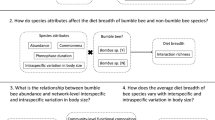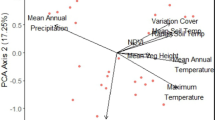Abstract
The number of larvae of the pit-digging ant-lion Macroleon quinquemaculatus at a food-poor site in Tanzania increased between May and October 1983 and then remained at high density until the following rainy season in March. Food availability was low and small larvae were most likely to suffer food shortage. Hunger level varied within and between instars: hunger was greatest after moults and only third-instar larvae weighing more than 100 mg were well fed. A simple model showed that exploitation competition was asymmetric and most likely to affect small larvae, by removing small prey. Exploitation was estimated to reduce food intake by 30–60%. Within-site differences in growth rate and size were associated with differences in larval density. Small larvae were much more likely to move than large larvae; the latter tended to occupy the periphery of the habitat. The reduction in food intake experienced by small larvae was a consequence of interference competition, which was the main factor operating at this site.
Similar content being viewed by others
References
Baur B, Baur A (1990) Experimental evidence for intra-and interspecific competition in two species of rock-dwelling land snails. J Anim Ecol 59: 301–315
Begon M (1984) Density and individual fitness: asymmetric competition. In: Shorrocks B (ed) Evolutionary ecology. Blackwell Scientific Publications, Oxford, pp 175–194
Crowley PH, Dillon PM, Johnson DM, Watson CN (1987) Intraspecific interference among larvae in a semivoltine dragonfly population. Oecologia 71: 447–456
Ebenman B (1988) Dynamics of age-and size-structured populations: intraspecific competition. In: Ebenman B, Persson L (eds) Size-structured populations. Springer, Berlin, pp 127–139
Fletcher WJ (1988) Intraspecific interactions between adults and juveniles of the subtidal limpet, Patelloidea mufria. Oecologia 75: 272–277
Gribbin SD, Thompson DJ (1990) Asymmetric intraspecific competition among larvae of the damselfly Ischnura elegans (Zygoptera: Coenagrionidae). Ecol Entomol 15: 37–42
Griffiths D (1981) Suboptimal foraging in the ant-lion Macroleon quinquemaculatus. J Anim Ecol 50: 697–702
Griffiths D (1985) Phenology and larval-adult size relations in the ant-lion Macroleon quinquemaculatus. J Anim Ecol 54: 573–582
Griffiths D (1986) Pit construction by ant-lion larvae: a cost-benefit analysis. J Anim Ecol 55: 39–57
Griffiths D (1991a) Intraspecific competition in larvae of the ant-lion Morter sp. and interspecific interactions with Macroleon quinquemaculatus. Ecol Entomol 16: 193–201
Griffiths D (1991b) Food availability and the use and storage of fat by ant-lion larvae. Oikos 60: 162–172
Griffiths D (1992) Interference competition in ant-lion Macroleon quinquemaculatus larvae. Ecol Entomol 17: 219–226
Hamrin SF, Persson L (1986) Asymmetrical competition between age classes as a factor causing population oscillations in an obligate planktivorous fish species. Oikos 47: 223–232
Heinrich B, Heinrich MJE (1984) The pit-trapping foraging strategy of the ant lion, Myrmeleon immaculatus DeGeer (Neuroptera: Myrmeleontidae). Behav Ecol Sociobiol 14: 151–160
Jenkins B, Kitching RL (1987) Component analysis and the modelling of the movement process: the interaction between ants and ant-lions. Aust J Zool 35: 313–318
Johnson DM, Crowley PH, Bohanon RE, Watson CN, Martin TH (1985) Competition among larval dragonflies: a field enclosure experiment. Ecology 66: 119–128
Lomnicki A (1988) Population ecology of individuals. Princeton University Press, Princeton
Lucas JR (1985) Metabolic rates and pit-construction costs of two antlion species. J Anim Ecol 54: 295–309
Matsura T (1987) An experimental study on the foraging behaviour of a pit-building antlion larvae, Myrmeleon bore. Res Popul Ecol 29; 17–26
Matsura T, Takano H (1989) Pit-relocation of antlion larvae in relation to their density. Res Popul Ecol 31: 225–234
McClure MS (1976) Spatial distribution of pit making ant lion larvae (Neuroptera: Myrmeleontidae): density effects. Biotropica 8: 179–183
Myers JP, Connors PG, Pitelka FG (1981) Optimal territory size and the sanderling: compromises in a variable environment. In: Kamil AC, Sargent TD (eds) Foraging behaviour. Garland STPM Press New York, pp 135–158
Persson L (1985) Asymmetrical competition: Are larger animals competitively superior? Am Nat 126: 261–266
Persson L (1987) The effects of resource availability and distribution on size class interactions in perch Perca fluviatilis. Oikos 48: 148–160
Polis GA (1981) The evolution and dynamics of intraspecific predation. Annu Rev Ecol Syst 12: 225–251
Polis G (1988) Exploitation competition and the evolution of interference, cannibalism, and intraguild predation in age/sizestructured populations. In: Ebenman B, Persson L (eds) Size-structured populations. Springer, Berlin, pp 185–202
Riechert SE (1978) Energy based territoriality in populations of the desert spider Agelenopsis aperta (Gertsch). Symp Zool Soc Lond 42: 211–222
Riechert SE (1981) The consequences of being territorial: speiders, a case study. Am Nat 117: 871–892
Simberloff D (1979) Nearest neighbour assessments of spatial configurations of circles rather than points. Ecology 60: 679–685
Simberloff DS, King L, Lowrie S, Lorence D, Schilling E (1978) Holes in the doughnut theory: the dispersion of ant-lions. Brenesia 14–15 13–46
Underwood AJ (1976) Food competition between age classes in the intertidal neritacean Nerita atramentosa (Reeve) (Gastropoda: Prosobranchia). Exp Mar Biol Ecol 23: 145–154
Werner EE (1986) Species interactions in freshwater fish communities. In: Diamond J, Case TJ (eds) Community ecology, Harper & Row, New York, pp 344–358
Wilson DS (1974) Prey capture and competition in the ant lion. Biotropica 6: 187–193
Wise DH (1975) Competitive mechanisms in a food-limited species: relative importance of interference and exploitative interactions among labyrinth spiders (Araneae: Araneidae). Oecologia 58: 1–9
Author information
Authors and Affiliations
Rights and permissions
About this article
Cite this article
Griffiths, D. Intraspecific competition in ant-lion (Macroleon quinquemaculatus) larvae in the field. Oecologia 93, 531–537 (1993). https://doi.org/10.1007/BF00328962
Received:
Accepted:
Issue Date:
DOI: https://doi.org/10.1007/BF00328962




